formerly eScholarship Editions


|
|
|
|
Your request for similar items found 20 book(s). | Modify Search | Displaying 1 - 20 of 20 book(s) | |
| 1. | 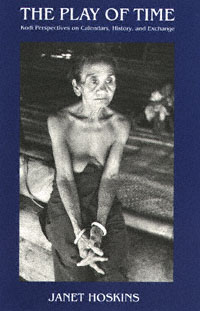 | Title: The play of time: Kodi perspectives on calendars, history, and exchange Author: Hoskins, Janet Published: University of California Press, 1997 Subjects: Anthropology | Cultural Anthropology | Southeast Asia Publisher's Description: Janet Hoskins provides both an ethnographic study of the organization of time in an Eastern Indonesian society and a theoretical argument about alternate temporalities in the modern world. Based on more than three years of field work with the Kodi people of the island of Sumba, her book focuses on Kodi calendrical rituals, exchange transactions, and confrontations with the historical forces of the colonial and postcolonial world. Hoskins explores the contingent, contested, and often contradictory precedent of the past to show how local systems of knowledge are in dialogue with wider historical forces.Arguing that traditional temporality is more complex than many theorists have realized, Hoskins highlights the flexibility and relativity of local time concepts, whose sophistication belies the cliche of simple societies living in a world outside of time. [brief] Similar Items |
| 2. | 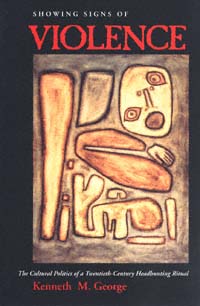 | Title: Showing signs of violence: the cultural politics of a twentieth-century headhunting ritual Author: George, Kenneth M 1950- Published: University of California Press, 1996 Subjects: Anthropology | Cultural Anthropology | Southeast Asia Publisher's Description: Showing Signs of Violence deals with the ceremonies of pangngae, a mock headhunt that lingers stubbornly at the center of political life in a marginal upland community in Sulawesi, Indonesia. No killing takes place in this ritual - no actual heads are taken - but its rhetoric of violence is unmistakable and real.Kenneth M. George vividly details the rites of pangngae, from the headhunters' secret and predatory journey downriver to the week of public festivity that follows their exuberant return. He puts special emphasis on the songs, speeches, and liturgies of the headhunt and shows how this ritual is neither a relic form of primitive violence nor an obsolete discourse on the social horizons of a remote community. In fact, the themes, purposes, and circumstances of pangngae make it the most public and community-defining form of ceremonial violence for this small mountain enclave as it confronts the dilemmas presented by Indonesian modernity and state culture. [brief] Similar Items |
| 3. | 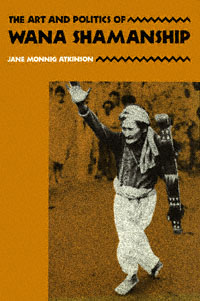 | Title: The art and politics of Wana shamanship Author: Atkinson, Jane Monnig Published: University of California Press, 1992 Subjects: Anthropology | Cultural Anthropology | Southeast Asia | Religion | Gender Studies Publisher's Description: Rituals are valued by students of culture as lenses for bringing facets of social life and meaning into focus. Jane Monnig Atkinson's carefully crafted study offers unique insight into the rich shamanic ritual tradition of the Wana, an upland population of Sulawesi, Indonesia. Similar Items |
| 4. | 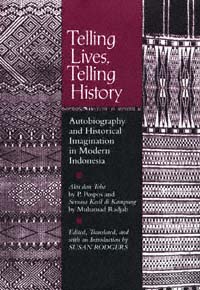 | Title: Telling lives, telling history: autobiography and historical imagination in modern Indonesia Author: Rodgers, Susan 1949- Published: University of California Press, 1995 Subjects: Anthropology | Cultural Anthropology | Southeast Asia | Asian History Publisher's Description: These two memoirs, superbly rendered into English for the first time, provide unique windows into the Sumatran past, in particular, and the early twentieth-century history of Southeast Asia, in general. Originally published soon after the Indonesian Revolution (1945-1949) liberated the island chain from Dutch control, these unusually insightful narratives recall the authors' boyhoods in rural Toba Batak and Minangkabau villages. In reconstructing their own passage into adulthood, the writers inevitably tell the story of their country's turbulent journey from colonial subjugation through revolution to independence. Susan Rodgers's perceptive introduction illuminates the importance of autobiography in developing historical consciousness and imagining a national future. [brief] Similar Items |
| 5. |  | Title: Risk and rationality: philosophical foundations for populist reforms Author: Shrader-Frechette, K. S 1944- Published: University of California Press, 1991 Subjects: Philosophy | Ethics | Social Problems | Political Theory Publisher's Description: Only ten to twelve percent of Americans would voluntarily live within a mile of a nuclear plant or hazardous waste facility. But industry spokespersons claim that such risk aversion represents ignorance and paranoia, and they lament that citizen protests have delayed valuable projects and increased their costs.Who is right? In Risk and Rationality , Kristin Shrader-Frechette argues that neither charges of irresponsible endangerment nor countercharges of scientific illiteracy frame the issues properly. She examines the debate over methodological norms for risk evaluation and finds analysts arrayed in a spectrum. Points of view extend from cultural relativists who believe that any risk can be justified (since no rational standards are ultimately possible) to naive positivists who believe that risk evaluation can be objective, neutral, and value free. Both camps, she argues, are wrong, because risk evaluation as a social process is rational and objective, even though all risk-evaluation rules are value-laden.Shrader-Frechette defends a middle position called "scientific proceduralism." She shows why extremist views are unreliable, reveals misconceptions underlying current risk-evaluation methods and strategies, and sketches the reforms needed to set hazard assessment and risk evaluation on a publicly defensible foundation.These reforms involve mathematical, economic, ethical, and legal procedures. They constitute a new paradigm for assessment when acceptance of public hazards is rational, recognizing that laypersons are often more rational in their evaluation of societal risks than either experts or governments have acknowledged. Such reforms would provide citizens with more influence in risk decisions and focus on mediating ethical conflicts, rather than seeking to impose the will of experts. Science, she argues, need not preclude democracy. [brief] Similar Items |
| 6. |  | Title: Three Mile Island: a nuclear crisis in historical perspective Author: Walker, J. Samuel Published: University of California Press, 2004 Subjects: History | Technology and Instruments | Environment | Technology and Society | United States History Publisher's Description: Twenty-five years ago, Hollywood released The China Syndrome, featuring Jane Fonda and Michael Douglas as a TVnews crew who witness what appears to be a serious accident at a nuclear power plant. In a spectacular coincidence, on March 28, 1979, less than two weeks after the movie came out, the worst accident in the history of commercial nuclear power in the United States occurred at Three Mile Island. For five days, the citizens of central Pennsylvania and the entire world, amid growing alarm, followed the efforts of authorities to prevent the crippled plant from spewing dangerous quantities of radiation into the environment. This book is the first comprehensive account of the causes, context, and consequences of the Three Mile Island crisis. In gripping prose, J. Samuel Walker captures the high human drama surrounding the accident, sets it in the context of the heated debate over nuclear power in the seventies, and analyzes the social, technical, and political issues it raised. His superb account of those frightening and confusing days will clear up misconceptions held to this day about Three Mile Island. The heart of Walker's suspenseful narrative is a moment-by-moment account of the accident itself, in which he brings to life the players who dealt with the emergency: the Nuclear Regulatory Commission, the state of Pennsylvania, the White House, and a cast of scientists and reporters. He also looks at the aftermath of the accident on the surrounding area, including studies of its long-term health effects on the population, providing a fascinating window onto the politics of nuclear power and an authoritative account of a critical event in recent American history. [brief] Similar Items |
| 7. | 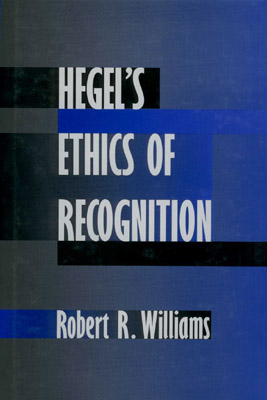 | Title: Hegel's ethics of recognition Author: Williams, Robert R 1939- Published: University of California Press, 1998 Subjects: Philosophy | Ethics Publisher's Description: In this significant contribution to Hegel scholarship, Robert Williams develops the most comprehensive account to date of Hegel's concept of recognition ( Anerkennung ). Fichte introduced the concept of recognition as a presupposition of both Rousseau's social contract and Kant's ethics. Williams shows that Hegel appropriated the concept of recognition as the general pattern of his concept of ethical life, breaking with natural law theory yet incorporating the Aristotelian view that rights and virtues are possible only within a certain kind of community.He explores Hegel's intersubjective concept of spirit ( Geist ) as the product of affirmative mutual recognition and his conception of recognition as the right to have rights. Examining Hegel's Jena manuscripts, his Philosophy of Right , the Phenomenology of Spirit , and other works, Williams shows how the concept of recognition shapes and illumines Hegel's understandings of crime and punishment, morality, the family, the state, sovereignty, international relations, and war. A concluding chapter on the reception and reworking of the concept of recognition by contemporary thinkers including Derrida, Levinas, and Deleuze demonstrates Hegel's continuing centrality to the philosophical concerns of our age. [brief] Similar Items |
| 8. | 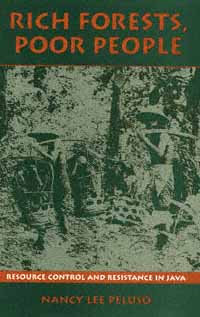 | Title: Rich forests, poor people: resource control and resistance in Java Author: Peluso, Nancy Lee Published: University of California Press, 1992 Subjects: Anthropology | Ecology | Southeast Asia | Environmental Studies | Anthropology Publisher's Description: Peluso untangles the complex of peasant and state politics that has developed in Java over three centuries. Similar Items |
| 9. | 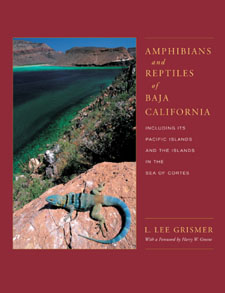 | Title: Amphibians and reptiles of Baja California, including its Pacific islands, and the islands in the Sea of Cortés Author: Grismer, L. Lee 1955- Published: University of California Press, 2002 Subjects: Organismal Biology | Natural History | California and the West | Herpetology Publisher's Description: The Baja California peninsula is home to many forms of life found nowhere else on earth. This, combined with the peninsula's rugged and inaccessible terrain, has made the area one of the last true biological frontiers of North America. L. Lee Grismer is not only the foremost authority on the amphibians and reptiles of Baja California, but also an outstanding photographer. He has produced the most comprehensive work on the herpetofauna of the peninsula and its islands ever published. With its stunning color images, detailed accounts of many little-known species, and descriptions of the region's diverse environment, this is the definitive guide to the amphibians and reptiles of a fascinating and remote region. The culmination of Grismer's quarter century of fieldwork on the Baja peninsula and his exploration of more than one hundred of its islands in the Pacific Ocean and the Sea of Cortés, this book gives information on the identification, distribution, natural history, and taxonomy of each species of amphibian and reptile found there. Preliminary accounts of the life history of many of the salamanders, frogs, toads, turtles, lizards, and snakes are reported here for the first time, and several species that were almost unknown to science are illustrated in full color. The book also contains new data on species distribution and on the effect of the isolated landscape of the peninsula and its islands on the evolutionary process. Much of the information gathered here is presented in biogeographical overviews that consider the extremely varied environments of Baja California in both a contemporary and a historical framework. An original and important contribution to science, this book will generate further research for years to come as it becomes a benchmark reference for both professionals and amateurs. [brief] Similar Items |
| 10. | 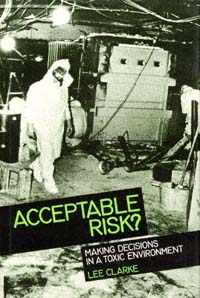 | Title: Acceptable risk?: making decisions in a toxic environment Author: Clarke, Lee Ben Published: University of California Press, 1989 Subjects: Sociology | Technology and Society | Environmental Studies | Public Policy Publisher's Description: Organizations and modern technology give us much of what we value, but they have also given us Chernobyl, Three Mile Island, and Bhopal. The question at the heart of this paradox is "What is acceptable risk?" Based on his examination of the 1981 contamination of an office building in Binghamton, New York, Lee Clarke's compelling study argues that organizational processes are the key to understanding how some risks rather than others are defined as acceptable. He finds a pattern of decision-making based on relationships among organizations rather than the authority of individuals or single agencies. [brief] Similar Items |
| 11. |  | Title: The possessed and the dispossessed: spirits, identity, and power in a Madagascar migrant town Author: Sharp, Lesley Alexandra Published: University of California Press, 1994 Subjects: Anthropology | African Studies | Medical Anthropology | Women's Studies | Indigenous Religions Publisher's Description: This finely drawn portrait of a complex, polycultural urban community in Madagascar emphasizes the role of spirit medium healers, a group heretofore seen as having little power. These women, Leslie Sharp argues, are far from powerless among the peasants and migrant laborers who work the land in this plantation economy. In fact, Sharp's wide-ranging analysis shows that tromba , or spirit possession, is central to understanding the complex identities of insiders and outsiders in this community, which draws people from all over the island and abroad.Sharp's study also reveals the contradictions between indigenous healing and Western-derived Protestant healing and psychiatry. Particular attention to the significance of migrant women's and children's experiences in a context of seeking relief from personal and social ills gives Sharp's investigation importance for gender studies as well as for studies in medical anthropology, Africa and Madagascar, the politics of culture, and religion and ritual. [brief] Similar Items |
| 12. | 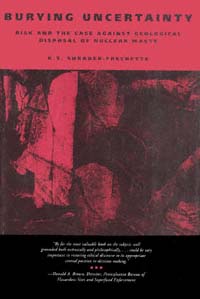 | Title: Burying uncertainty: risk and the case against geological disposal of nuclear waste Author: Shrader-Frechette, K. S. (Kristin Sharon) Published: University of California Press, 1993 Subjects: Science | Ecology | Public Policy Publisher's Description: Shrader-Frechette looks at current U.S. government policy regarding the nation's high-level radioactive waste both scientifically and ethically.What should be done with our nation's high-level radioactive waste, which will remain hazardous for thousands of years? This is one of the most pressing problems faced by the nuclear power industry, and current U.S. government policy is to bury "radwastes" in specially designed deep repositories.K. S. Shrader-Frechette argues that this policy is profoundly misguided on both scientific and ethical grounds. Scientifically - because we cannot trust the precision of 10,000-year predictions that promise containment of the waste. Ethically - because geological disposal ignores the rights of present and future generations to equal treatment, due process, and free informed consent.Shrader-Frechette focuses her argument on the world's first proposed high-level radioactive waste facility at Yucca Mountain, Nevada. Analyzing a mass of technical literature, she demonstrates the weaknesses in the professional risk-assessors' arguments that claim the site is sufficiently safe for such a plan. We should postpone the question of geological disposal for at least a century and use monitored, retrievable, above-ground storage of the waste until then. Her message regarding radwaste is clear: what you can't see can hurt you. [brief] Similar Items |
| 13. | 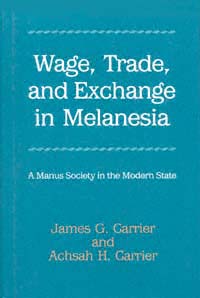 | Title: Wage, trade, and exchange in Melanesia: a Manus society in the modern state Author: Carrier, James G Published: University of California Press, 1989 Subjects: Anthropology Publisher's Description: Ponam Island, a small community in Manus Province, Papua New Guinea, is the subject of this innovative study. The authors extend the criticism within anthropology of ethnographies that attempt to analyze village communities without reference to the nations of which they are a part, and that equate the traditional and the exotic with the untouched. They do so by describing the links between a peripheral village society and Papua New Guinea's national economy and institutions, in a way that will interest all those concerned with development and underdevelopment.The analysis focuses on major socioeconomic areas of village life: education, migration, wage employment, and remittance; trade, commerce, and exchange; subsistence fishing; ceremonial exchange. The authors' findings challenge the idea that colonial and Western-oriented encroachment leads to the decay of village societies or to their adopting Western values and practices. Ponam has been under significant Western influence for almost a century, yet the society has not decayed. It remains flourishing and generative, uniquely itself and neither blindly traditional nor mindlessly Western. [brief] Similar Items |
| 14. | 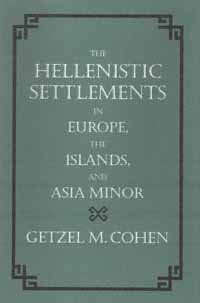 | Title: The Hellenistic settlements in Europe, the islands, and Asia Minor Author: Cohen, Getzel M Published: University of California Press, 1996 Subjects: Classics | History | Ancient History Publisher's Description: This compendium provides historical narratives, detailed references, citations, and commentaries on all the cities founded or refounded in Europe, The Islands, and Asia Minor during the Hellenistic period. Organized coherently in more than 180 entries, it is one of the most significant reference wor . . . [more] Similar Items |
| 15. | 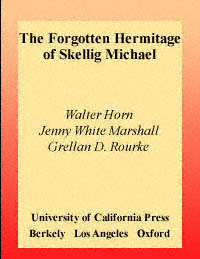 | Title: The forgotten hermitage of Skellig Michael Author: Horn, Walter William 1908- Published: University of California Press, 1990 Subjects: Architecture | Art | Architectural History | Medieval Studies Publisher's Description: This book is a dramatically told and visually stunning account of a ninth-century hermitage discovered on the South Peak of Skellig Michael, an island off the west coast of Ireland. It is the story, pieced together from fragmentary remains, study, and conjecture, of a man's attempt to live on a tiny ledge some 700 feet above the Atlantic on the outer edge of the European land mass, alone, as close to God as possible, in what is perhaps the ne plus ultra of ecstatic monastic solitude.Richly illustrated with maps, plans, and photographs that capture both the astonishing beauty and isolation of the hermitage, the text also includes reconstruction drawings of the site that combine a surveyor's accuracy with an artist's imaginative response to the hermit who found spiritual refuge on a pinnacle. [brief] Similar Items |
| 16. | 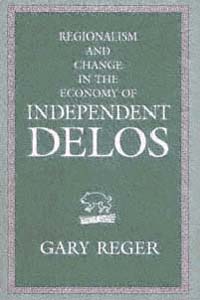 | Title: Regionalism and change in the economy of independent Delos, 314-167 B.C Author: Reger, Gary Published: University of California Press, 1994 Subjects: Classics | History | Archaeology | Economics and Business | Ancient History Publisher's Description: Gary Reger's highly original book applies modern statistical analysis to the detailed inscriptions at the Temple of Apollo on Delos. These inscriptions, discovered during excavations in the late nineteenth and early twentieth centuries, provide a wealth of information about the business and economic enterprises of the island from 314 to167 B.C.Reger examines the abundant data from the inscriptions and seeks patterns in the production and use of commodities (olive oil, pigs, firewood, barley, wheat) and in fluctuations in rents for real estate. Linking the island's economic history to the larger political scene, he offers a trenchant and overdue argument for an analysis of the Delian economy as a regional phenomenon, not - as others have seen it - as a center of international exchange. [brief] Similar Items |
| 17. | 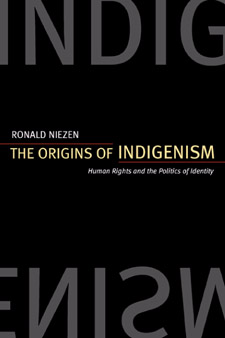 | Title: The origins of indigenism: human rights and the politics of identity Author: Niezen, Ronald Published: University of California Press, 2003 Subjects: Anthropology | Ethnic Studies | International Relations | Social Problems Publisher's Description: "International indigenism" may sound like a contradiction in terms, but it is indeed a global phenomenon and a growing form of activism. In his fluent and accessible narrative, Ronald Niezen examines the ways the relatively recent emergence of an internationally recognized identity - "indigenous peoples" - intersects with another relatively recent international movement - the development of universal human rights laws and principles. This movement makes use of human rights instruments and the international organizations of states to resist the political, cultural, and economic incursions of individual states. The concept "indigenous peoples" gained currency in the social reform efforts of the International Labor Organization in the 1950s, was taken up by indigenous nongovernmental organizations, and is now fully integrated into human rights initiatives and international organizations. Those who today call themselves indigenous peoples share significant similarities in their colonial and postcolonial experiences, such as loss of land and subsistence, abrogation of treaties, and the imposition of psychologically and socially destructive assimilation policies. Niezen shows how, from a new position of legitimacy and influence, they are striving for greater recognition of collective rights, in particular their rights to self-determination in international law. These efforts are influencing local politics in turn and encouraging more ambitious goals of autonomy in indigenous communities worldwide. [brief] Similar Items |
| 18. | 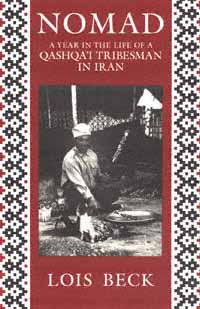 | Title: Nomad: a year in the life of a Qashqa'i tribesman in Iran Author: Beck, Lois 1944- Published: University of California Press, 1991 Subjects: Anthropology | Cultural Anthropology | Middle Eastern Studies | Middle Eastern History Publisher's Description: Borzu Qermezi was the headman and political leader of a group of nomadic pastoralists who were part of the Qashqa'i confederacy of southwest Iran. Proud, complex, strong-willed, witty, and cunning, Borzu successfully led his people on their annual migrations for many years. He regulated their travel; mediated conflicts; intervened in (and sometimes exacerbated) tense situations between his people and other nomads; and dealt with the government police agency. Structuring the account around the four seasons, Lois Beck recounts the day-to-day activities of Borzu during the year she spent traveling with his people. She describes the rigors of nomadic life and the consequences of decisions made in haste.During 1970 to 1971, Borzu and his people were faced with many difficulties. When the expected winter rains did not fall, pastures and crops shriveled. Unable to sell their starving livestock for any profit, Borzu's people saw their debts to urban merchants and moneylenders increase. At the same time, Iran exercised more bureaucratic control over the Qashqa'i by applying new policies over migratory schedules and the allocation of scarce pastures, and by introducing non-Qashqa'i agriculturalists and livestock investors as legitimate land users. All these measures threatened the nomad's way of life and eventually undermined the role of headmen such as Borzu. Lois Beck details the vicissitudes endured by Borzu's people and the strategies he devised to cope with them.Blending ethnographic and historical material, this book contains information unavailable for other tribal and nomadic pastoral groups in the Middle East and central Asia. Through Beck's deft analysis, we come to understand why nomadic pastoralism was once an important part of this vast region, and why tribal society has endured. [brief] Similar Items |
| 19. | 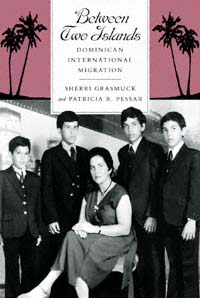 | Title: Between two islands: Dominican international migration Author: Grasmuck, Sherri Published: University of California Press, 1991 Subjects: Sociology | Latino Studies | Latin American Studies | Anthropology Publisher's Description: Popular notions about migration to the United States from Latin America and the Caribbean are too often distorted by memories of earlier European migrations and by a tendency to generalize from the more familiar cases of Mexico and Puerto Rico. Between Two Islands is an interdisciplinary study of Dominican migration, challenging many widespread, yet erroneous, views concerning the socio-economic background of new immigrants and the causes and consequences of their move to the United States.Eschewing monocausal treatments of migration, the authors insist that migration is a multifaceted process involving economic, political, and socio-cultural factors. To this end, they introduce an innovative analytical framework which includes such determinants as the international division of labor; state policy in the sending and receiving societies; class relations; transnational migrant households; social networks; and gender and generational hierarchies.By adopting this multidimensional approach, Grasmuck and Pessar are able to account for many intriguing paradoxes of Dominican migration and development of the Dominican population in the U.S. For example, why is it that the peak in migration coincided with a boom in Dominican economic growth? Why did most of the immigrants settle in New York City at the precise moment the metropolitan economy was experiencing stagnation and severe unemployment? And why do most immigrants claim to have achieved social mobility and middle-class standing despite employment in menial blue-collar jobs?Until quite recently, studies of international migration have emphasized the male migrant, while neglecting the role of women and their experiences. Grasmuck and Pessar's attempt to remedy this uneven perspective results in a better overall understanding of Dominican migration. For instance, they find that with regard to wages and working conditions, it is a greater liability to be female than to be without legal status. They also show that gender influences attitudes toward settlement, return, and workplace struggle.Finally, the authors explore some of the paradoxes created by Dominican migration. The material success achieved by individual migrant households contrasts starkly with increased socio-economic inequality in the Dominican Republic and polarized class relations in the United States.This is an exciting and important work that will appeal to scholars and policymakers interested in immigration, ethnic studies, and the continual reshaping of urban America. [brief] Similar Items |
| 20. |  | Title: The ones that are wanted: communication and the politics of representation in a photographic exhibition Author: Kratz, Corinne Ann 1953- Published: University of California Press, 2002 Subjects: Anthropology | Cultural Anthropology | African Studies | Photography | Art Theory Publisher's Description: The Okiek people of Kenya's forested highlands have a long history of hunting, honey gathering, and trading with their Maasai and Kipsigis neighbors; several decades ago, they also began farming and herding. This book follows a traveling exhibition of anthropologist Corinne Kratz's photographs of the Okiek through showings at seven venues, including the National Museum in Nairobi and the Smithsonian Institution in Washington, D.C. Kratz tells the story of the exhibition--the stereotypes it sought to challenge, how commentaries by Okiek people were incorporated, and different ways that viewers in Kenya and the United States understood it. In addition to presenting wonderful images of a little-known people, this inviting book explores the exhibition medium itself, focusing on the complexities and possibilities of cultural representation. Walking a fine line between the photographic intimacy of a family album and the ethnographic distance of documentary photography, The Ones That Are Wanted reproduces the exhibition in full, with its vibrant color photographs, multilingual captions, and lively commentary. Throughout, Kratz incorporates insightful reflections on her changing involvement with the exhibition as anthropologist, photographer, and curator, and she provides perceptive discussions of such topics as photography in Kenya, stereotypes, and the post-1970s proliferation of the politics of representation. [brief] Similar Items |